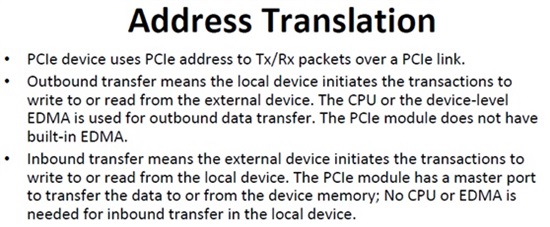Hi everyone:
Recently ,I need to use PCIE in my daily work.And I had saw some reference material.But
I cannot understand the meaning of inbound and outbound all the time.
In my opinion, For the same PCIE visit or access,you can say inbound and you also say outbound
too.
For example,Now I suppose RC(played by PC linux host) access EP (played by DSP c6678) via PCIE.
According to one of the reference material I found in google below:
I think I can say this access belongs to inbound and I also can say this access belongs to outbound.
it's all decided from which side.
1.From PC host RC side
According to the above reference material ,PC host RC can be considered as the local device.
and DSP c6678 EP can be considered as the external device.So the access initiates by local device
_PC host linux RC. Of courese this situation belongs to outbound .
2.From the 6678 DSP EP side
Also on the basis of reference material above.
We also can consider the ep or dsp or c6678 as the local device and consider PC or HOST linux or
RC as the external device.On this case.We can said that the external device initiates the access or
read/write operation.If this so,We of course definitely consider this situation as inbound.
So the conclusion like this:
I think wherever it can be considered as inbound or outbound is decided that
who is local device and who is the external device.
Because from different side or view.That question have different answers.
That's the reason that I consider you can say it belongs to inbound and also
can say it belongs to outbound.
Do you agree with me? Any advice will be appreciated.
Best Regards!


